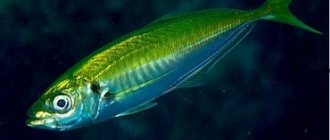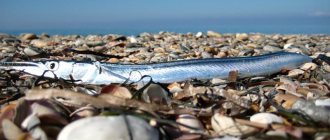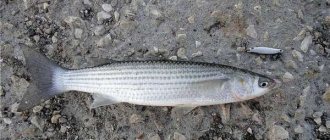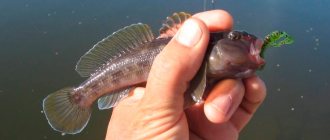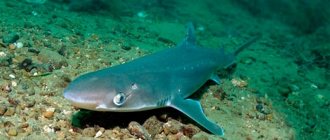Due to the many fishing vessels, cruise ships, dense surroundings by different countries, low salinity and relatively cold waters compared to the Red Sea, and most importantly, almost complete isolation from ocean waters, the Black Sea depths are not interesting for large sharks. But, of course, there are certain types of sharks in the Black Sea.
More details about these types:
Katran
The most common shark species in Black Sea waters. The length of the katran is up to a meter and a little more; individuals up to two meters are rare. The body is long, strewn with spines, which have a structure similar to teeth, i.e. The spine contains dentin, pulp, and a coating on the outside like tooth enamel. The snout is slightly reminiscent of a dog's, which is why the katran is sometimes called a sea dog. The mouth contains many sharp and small teeth in rows. The fish weighs from eight to twelve kilograms.
Katrans prefer to live in schools at a depth of up to one hundred and twenty meters; they feed on anchovy, gobies, sprat, horse mackerel and other fish. Sometimes, mainly female Katrans, can hunt dolphins.
The female's pregnancy lasts almost eighteen months, then about fifteen fry are born, up to thirty centimeters in size. Compared to their other relatives, Black Sea katrans do not live long, up to twenty years.
Balyk is made from the meat of the Black Sea shark, and the liver contains a large amount of vitamins, fats, and other substances that have a therapeutic effect on certain diseases.
Katrans never attack people, although you can get hurt on their sharp thorns, so you shouldn’t get close to them. Also, a fish can bite a fisherman whose net it is entangled in.
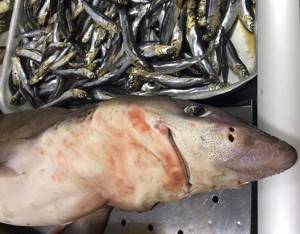
cat shark
The head of this fish resembles that of a cat, hence its name. This shark is also called scyllium. Their length is no more than one meter, weight up to one and a half kilograms. The streamlined, elongated body allows it to move rapidly in the depths of the sea in pursuit of prey. There are many small teeth in the mouth, which, like a brush, are capable of grinding any food.
The cat shark's diet consists of squid, shellfish, crabs, small fish, and octopus. Feeling impulses emanating from potential food, they hunt freely in the dark. They themselves also often become prey to larger marine inhabitants.
The scyllium reproduces, laying up to twenty eggs at the bottom of the clutch.
For humans, the cat shark is absolutely safe; moreover, it itself is afraid of people and hides.
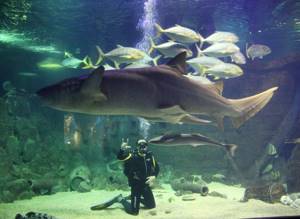
sea fox
Other names: spiny or spiny stingray. It has a diamond-shaped body with a short head, two fins like wings on the sides. The top of the body is covered with spines. The teeth are very sharp, so fishermen, having caught a stingray, first stun it with a blow to the head to avoid a very traumatic bite. The body length of the stingray is up to seventy centimeters, females are larger, reaching up to one hundred and twenty centimeters. This fish got its name sea fox because of its ability to camouflage and hide on the seabed. The habitat ranges from two to forty meters.
The diet consists of crabs and small fish. The process of reproduction occurs by laying eggs. The female can lay about a hundred eggs in a few weeks.
An interesting fact from the life of a stingray is the complete change of skin at a young age. Sometimes tourists come across black scraps of clothing washed up on the shore.
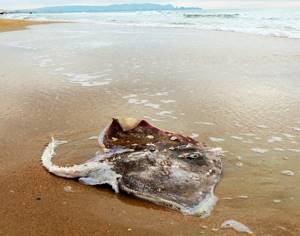
Angelfish
Another of the sharks in the Black Sea, which looks like a stingray. It also has the name squatina. Angel, the shark is named for its large side fins that resemble developing wings. The skin is covered with prickly spines, and the mouth has sharp teeth. Females are larger than males, some individuals reach almost two and a half meters in length.
Squatina prefers a nocturnal lifestyle. It feeds on fish, crabs, algae, and even sometimes seabirds.
The angelfish is considered an ovoviviparous shark; the offspring can be up to twenty-five pups.
This shark is not dangerous for humans, but it can cause serious injuries to fishermen when caught, so you should be extremely careful when catching squatfish.
The meat of the sharks listed above has incredible taste and beneficial properties. The famous sea soup is prepared from the fins of the katran; grill steaks; Shark meat is also used in salads; for cold and hot snacks, as well as baked goods. The best balyks are made from shark meat. One hundred grams of shark meat contain no carbohydrates, only nine grams of fat, twenty grams of protein, and only spinal cartilage from the bones. Essentially, it is a tender, juicy, white fish fillet with a pinkish tint.
To see and try Black Sea sharks, you can go on paid fishing trips, which are organized at almost all resorts on the Black Sea coast. Having gone out on a boat into the open sea, tourists can catch a katran on their own, and the cook on the ship will immediately prepare an excellent lunch from it. The same Katrans are sold at fish markets; a carcass costs from four hundred and fifty rubles per kilogram. The price will be higher in the supermarket. If you don’t want to cook yourself, order a dish of shark meat at a fish restaurant, of which there are many along the coast.
You can simply watch sharks and even take their photos in the aquariums of resort cities.
And finally, I would like to note that sometimes large sharks get into the Black Sea, although for these individuals it is very difficult. This is a white shark that lives in the Mediterranean Sea. Since after climate change, the waters of the Black Sea have become warmer than before, the white guest can swim into the Black Sea territory, but not for long. Also, there is one known case of fishermen catching a goblin shark, a resident of the Pacific Ocean. Only the katran and cat shark live permanently in the Black Sea. There have been no cases of shark attacks on humans on the Black Sea coast, but this does not mean that you need to neglect your own safety measures. The depths of the sea hold many unsolved secrets.

Popular questions and answers
Are there sharks in the Black Sea? Yes, in the Black Sea there are katran and cat shark (scyllium).
What sharks swim into the Black Sea? In addition to the Katran and catshark, white shark, fox shark, and hammerhead shark swim here.
Are there sharks that are dangerous to human life? A vacationer can be attacked by both a white shark and a hammerhead shark. In this case, the person is in mortal danger. In some cases, you can suffer from a katran bite.
Do sharks attack in the Black Sea? Yes, sometimes they attack. As an everywhere.
Are there statistics and cases of shark attacks on people in the Black Sea? There are no official statistics. To confirm a case of a shark attack, you need to draw up documents and convene a special commission that will make a conclusion and confirm or, on the contrary, refute the case of attack in the media.
Why are tourists afraid of shark attacks in Crimea? Because there were cases when fishermen and vacationers suffered from the bites of these predators.
Can a white shark swim into the Black Sea? Yes, sometimes white sharks, dangerous to humans, swim into the Black Sea. This does not happen often, so it is impossible to track and record such cases. When and how often a white shark swims into the Black Sea cannot be said with certainty.
Does the Goblin shark live in the Black Sea?
It is not found in the Black Sea. Or is it already happening? In 2013, a case was recorded when this rare predator was caught in a fishing boat's net. But most likely this is an isolated case.
And in this video clip you can see what sizes Black Sea sharks reach:
- Related Posts
- Pensions in Crimea in 2021 from January 1
- Spiders in Crimea: which ones are poisonous? What to do if bitten by a spider? How to protect yourself from spiders in nature?
Scary inhabitants of the deep sea...
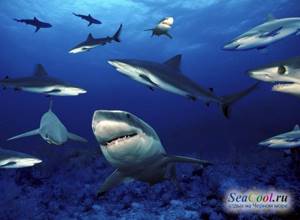
There are more than 450 species of “terrible” predators in the world. The smallest shark is the deep-dweller Etmopterus perryi. Her body length is only 17 centimeters. The largest is the whale shark with a body length of about 20 meters, which is also the largest fish on the planet.
“Wow the size! I wouldn’t want to meet her on the Black Sea!” - tourists will think and they will be wrong: giant sharks - whale and giant - are completely harmless to humans. They feed on plankton and small crustaceans, filtering sea water like whales. But representatives of smaller species - nurse sharks and leopard sharks - sometimes show unexpected aggressiveness and attack swimmers.
The list of dangerous shark species today consists of fifty species, and among them there are those that pose a threat to human life. The leaders of this “red” rating are:
- bull shark (aggressive, has long been known for attacks on people; man-eater);
- white shark (the legendary man-eating shark, also the main character of the film “Jaws”);
- tiger shark (one of the most common species on Earth; man-eater);
- long-winged shark (a most dangerous species; a man-eater that has caused the death of thousands of people stranded in the water due to shipwrecks or plane crashes);
- mako shark (often attacks people, killing or maiming them);
- gray reef shark (cases of attacks on divers have been recorded);
- sand shark (single attacks on people);
- hammerhead shark (despite its ominous appearance, humans are rarely attacked);
- blue shark (as of 2011, 34 attacks on humans were recorded, of which 8 attacks resulted in the death of the victim);
- lemon shark (no cases of attacks with “consequences” have been recorded; considered potentially dangerous to humans).
The only way sharks can get from the World Ocean to the Black Sea is from the Mediterranean Sea through the Bosphorus Strait. In Mediterranean waters there are about 47 species of dangerous predators, of which in 16 species some individuals reach 3 meters in length. 15 species of Mediterranean sharks are considered potentially dangerous to humans. Checking the lists, we discover the already familiar “man-eaters”: white and bull sharks.
Sharks of the Black Sea
Many people know that the Black Sea is one of the safest in the world. There are few poisonous fish here, no sea urchins, no sea snakes, no sharp corals, and even of the two jellyfish that live, only one stings - and that only causes redness of the skin. And only one species of shark lives here, and it’s only a meter in size. Is there only one type?
The Black Sea is practically closed. It has only two small straits connecting with other seas: on the one hand, the Kerch Strait with the Sea of Azov, on the other, through the Bosphorus, with the Marmara and Aegean Seas, and then the Mediterranean and the Atlantic Ocean. And if you can’t expect live surprises from the Sea of Azov, then through the Bosphorus Gate a lot of interesting things enter the Black Sea, including sharks. Many different sharks!
Black Sea Katran (Squalus acanthias ponticus)
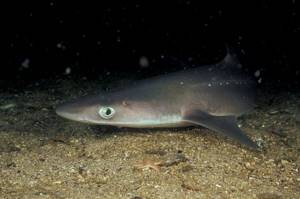
Black Sea Katran (Squalus acanthias ponticus). Photo fishbiosystem.ru
This is the “only” shark of the Black Sea. More precisely, it is the only permanently living one. The Black Sea subspecies is one of the most common shark species in the world. Here they reach their largest sizes, up to about 2 meters, but are not dangerous to humans. The basis of the diet is fish, and quite small ones: anchovy, sprat, red mullet, sardine, herring and others.
The main threat to the population is overfishing. This is due to the extremely low rate of reproduction, late sexual maturity (occurs at the age of 13–17 years) and the long period of development of eggs and embryos in the female’s body (about 18 months). Previously, the katran was more numerous, but now there are quite a lot of them, and the predator is not listed in the Red Data Books of the countries of the region. Although in some countries this issue is already beginning to be raised.
Commercial shark fishing is permitted, but, for example, in Russia it is caught much less than the permitted quota.
Common catshark (Scyliorhinus canicula)
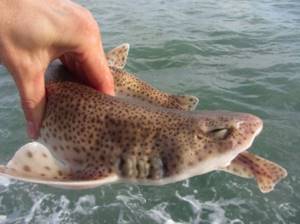
Common catshark (Scyliorhinus canicula). Photo by Copejans Evy
Another small shark (up to 1 meter), quite often found in the Black Sea. This is a bottom-dwelling species that feeds on crabs, shrimp and even worms. Like the katran, it does not pose a danger to humans, especially since it is active at night.
It is regularly recorded off the Turkish coast, less often near Bulgaria. In terms of the frequency of encounters in the Black Sea, it can safely be placed in second place. Some sites dedicated to fishing in the Black Sea talk about methods of catching cat sharks, although it was not possible to find a photo of the trophy.
Longspined spiny shark (Squalus blainville)
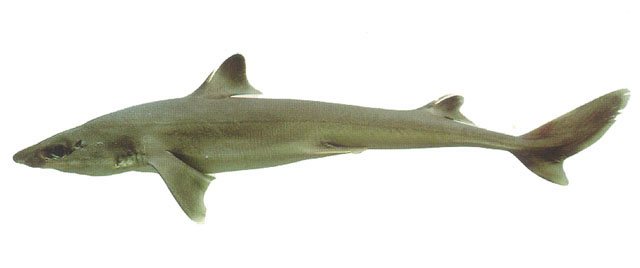
Longspined spiny shark (Squalus blainville). Photo fishbiosystem.ru
Another small shark and the closest relative of the katran. Like Scyliorhinus canicula, it barely reaches 1 meter in length. The range covers the Atlantic, Indian and Pacific oceans. There is a fairly large population in the Mediterranean Sea, and it is commercially fished.
It is a fairly frequent visitor to the Black Sea and swims further than others. The long-spined shark has been spotted off the coast of Turkey, Bulgaria and neighboring Georgia.
Common sea fox (Alopias vulpinus)

Common sea fox (Alopias vulpinus) Photo gooddive.com
Now this is a shark of serious size. Its length is up to 6 meters, however, about half of this size is in the tail. It is generally the most unusual and noticeable part of a fish’s body. But this is not the only thing that makes the sea fox remarkable; its body temperature is always higher than the temperature of the surrounding water. This is extremely rare in fish.
Alopias vulpinus feeds on fish, most often small pelagic fish, such as bluefish, mackerel, herring, and garfish. When hunting prey, it can develop high speed. But, fortunately, it is not dangerous to humans, although there have been several cases of injuries inflicted by a shark.
In the Black Sea it is extremely rare to find off the coast of Turkey and Bulgaria. Until the middle of the last century, the sea fox was recorded relatively often in our waters, but in recent years it has become less and less common. The last known case occurred on November 8, 1996 near the Turkish city of Sile.
Angelfish (Squatina squatina)
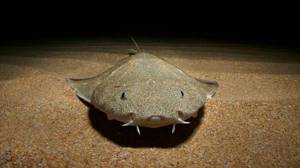
Angelfish (Squatina squatina). Photo by Michael Sealey
Another shark that periodically swims into the Black Sea and is nocturnal. Its beautiful name does not hide aggression. It is harmless and quite modest in size, with a maximum length of about 2 meters. Its shape immediately reveals a bottom predator, and at a quick glance it may even seem that it is a stingray.
In the Black Sea it was recorded off the coast of Turkey and Bulgaria. In recent years, there is no data on the capture of sea angel. Most likely, this is due to the fact that there is less of it in the neighboring seas - Marmara, Aegean and Mediterranean.
Hammerhead shark (Sphyrna zygaena)
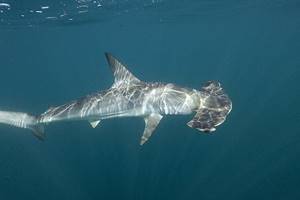
Hammerhead shark (Sphyrna zygaena). Photo by Andy Murch
The only potentially dangerous shark that swims into the Black Sea. Its length is up to 5 meters. This is a fast and quite aggressive predator. The basis of the diet is fish, such as herring, perch, and stingray.
Every year, dozens of attacks by these hammerhead sharks on people are recorded all over the world, but not in the Black Sea. Although we sometimes record this shark off the coast of Romania, Bulgaria and Turkey, it has never eaten people. And due to the decline in the number of the species in neighboring seas, the likelihood of Sphyrna zygaena entering the Black Sea through the Bosporus is becoming less and less.
Subscribe to our channel in Yandex.Zen
Statistics on shark attacks on humans
When planning a vacation on an Italian or French beach, do you need to be wary of marine predators?
Experts estimate that the chances of being caught in a shark's teeth are 1 in 11.5 million. That is, a person is at greater risk of dying from a lightning strike than being eaten while swimming in the open sea. The exception applies only to the coasts of Australia and South Africa, where there are really a lot of sharks. In the Mediterranean Sea they are much less common, if only because people do not form the main diet of these predators. Stories about man-eating sharks can be called exceptional. In fact, attacks on surfers and divers, not to mention those simply swimming, are extremely rare.
For example, in the United States, the death toll from shark bites is only one person per year. While the number of drowned citizens reaches 3306 over the same period. And since there are no large sharks in the Black Sea, cases of their attacks on people in Russia and Ukraine have also not been recorded.

